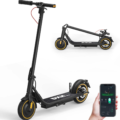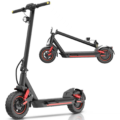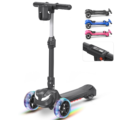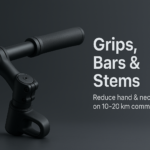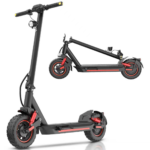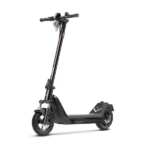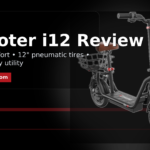DXH K8
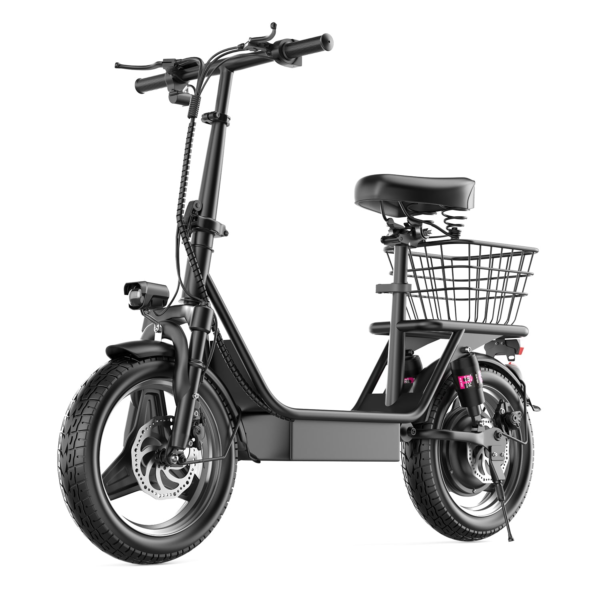

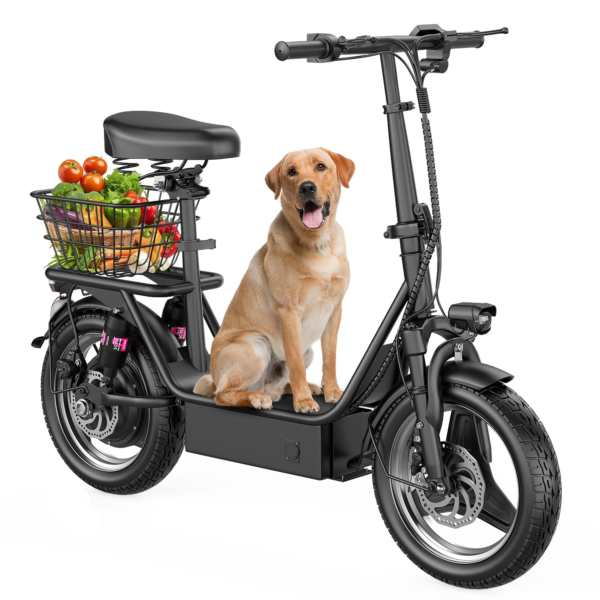
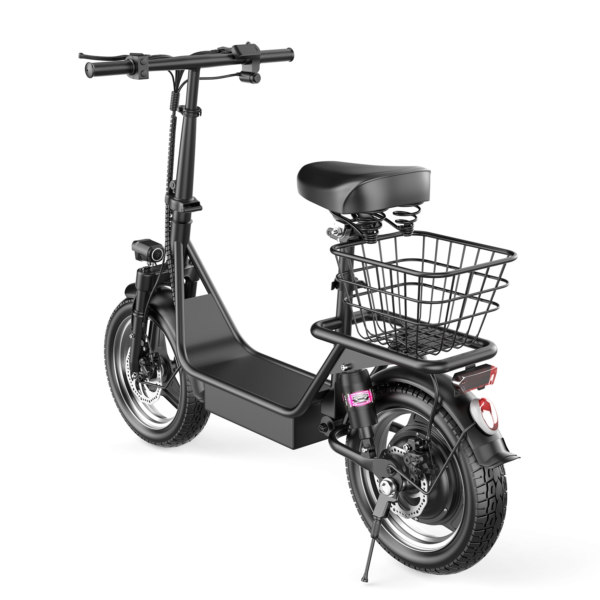
- Battery Range: 30 miles (48 km)
- Top Speed: 22 mph (35 km/h)
- Motor Power: 500 W
- Weight Capacity: 265 lb (120 kg)
- Charging Time: Not specified
- Scooter Weight: Not specified
PROS
- 500 W rear hub motor
- 48 V 10.4 Ah (499 Wh) battery
- Dual disc brakes (front & rear)
- Front & rear dual shocks
- 14″ fat tires; seated design
CONS
- Scooter weight not listed
- IP rating not specified
- Charge time not provided
- No official app mentioned
Table of contents
- What Is the DXH K8?
- How the DXH K8 Works
- Key Specifications (clean table)
- Design & Build Quality
- Performance Fundamentals
- Battery, Range & Efficiency
- Ride Quality & Comfort
- Braking & Safety Features
- Portability & Daily Usability
- Maintenance & Care
- Weather & Seasonal Considerations
- DXH K8 vs Alternatives
- Who the DXH K8 Is (and Isn’t) For
- FAQs
- Glossary
- Final Thoughts
If you want a tough, high-stability scooter with big tires, real road presence, and commuter-friendly safety touches, the DXH K8 deserves a serious look. It’s a large, road-oriented model built around stout suspension hardware and a feature-rich cockpit. This straightforward DXH K8 overview explains how it works, what to expect on the street, and how to care for it so it stays reliable for everyday rides.
What Is the DXH K8?
At its core, the DXH K8 is an adult electric scooter designed for stable urban travel. It pairs large street tires with a reinforced stem and a wide, flat deck to prioritize control and comfort. The cockpit centers on a round LCD with three selectable speed gears, clear icons, and a simple button layout. You also get dedicated controls for Single/Dual-motor operation, an Eco/Turbo performance toggle, a horn, turn signals, and a bright headlight for night visibility. The chassis includes front suspension to smooth out rough pavement, while disc brakes handle stopping duties.
Because the K8 rides on big wheels and has a sturdy fork, it feels more planted than smaller commuter scooters. Yet it still folds for storage—handy for apartment living, car trunks, and short multi-modal hops where you need to stow the scooter quickly.
How the DXH K8 Works
The K8 operates like a simple electric motorcycle, but it keeps stand-up scooter controls familiar and intuitive.
- Motors & Controller. Hub motors sit inside the wheels. A bar-mounted button selects Single (rear wheel) for efficient cruising or Dual for stronger acceleration and hill support. Think of Single as “eco/commuter” and Dual as “traction/boost.” A yellow Eco/Turbo toggle lets you choose calm or lively response, and the display’s Gears 1–3 cap top speed for different environments.
- Battery & Voltage Readout. A keyed power switch shows numeric battery voltage. This acts like a precise fuel gauge. Higher voltage indicates more energy in reserve; you’ll see it dip under heavy load (like hills) and rebound on flats. Watching the number helps you adjust on the fly—drop to Eco, switch to Single, or ride in a lower gear to stretch range.
- Throttle. A trigger-style throttle on the right grip delivers smooth power. Because the three speed gears limit output, you can tame acceleration in dense areas or let the scooter breathe on open stretches.
- Brakes. Mechanical disc brakes provide predictable, linear feel and dependable stopping power. The setup is straightforward to adjust and easy to keep consistent with routine checks.
- Lighting & Signals. A forward headlight, rear lighting, side accents, and turn signals increase your conspicuity in traffic. The built-in horn helps alert other road users, especially at intersections and multi-use paths.
Overall, the control scheme is simple: power on, select Single or Dual, choose Eco or Turbo, set a speed gear, and ride.
Key Specifications (clean table)
Values are presented in imperial first with metric in parentheses where available. When the maker does not publish a figure, the field is marked as “Not specified.”
| Block | Item | Value |
|---|---|---|
| General | Model | DXH K8 |
| Intended Use | Adult stand-up scooter for paved/urban roads | |
| Water Resistance | IPX4 (splash-resistant; avoid heavy rain and deep water) | |
| Display | Round LCD with Gears 1–3, Eco/Turbo toggle, speed in mph or km/h | |
| Performance & Power | Drive | Single/Dual-motor selection via handlebar button |
| Top Speed | Not specified | |
| Hill Climb | Not specified (behavior discussed below) | |
| Battery, Charging & Electrical | Voltage Indicator | Numeric voltage via the key switch (precise “fuel-gauge” behavior) |
| Charging | Use the included charger; status light red→green when full | |
| Build & Dimensions | Tires | 12-inch (≈305 mm) street-oriented pneumatic tires |
| Suspension | Front shock absorber assembly | |
| Unfolded Size | Not specified | |
| Folded Dimensions | Not specified (stem-fold latch for compact storage) | |
| Safety & Control | Braking | Mechanical disc brakes |
| Lights | Headlight, rear lights, side accents; integrated horn and turn signals | |
| Modes | Eco/Turbo; Gears 1–3; mph ↔ km/h; optional cruise control | |
| Features & Extras | Switchgear | Left-hand cluster for Single/Dual and Eco/Turbo |
| Security | Keyed power lock with voltage readout | |
| Visuals | RGB accent lighting | |
| Warranty & Compliance | Warranty Snapshot | Typical coverage on major electricals; wear items excluded; misuse and water ingress excluded |
Design & Build Quality
The DXH K8 emphasizes control, visibility, and confidence. The tall, reinforced stem and twin-tube front suspension give the front end a firmer, more motorcycle-like stance. The wide handlebar reduces twitchiness and helps you steer with small, precise inputs. Because the deck is long and flat, it’s easy to shift your feet for balance—forward for heavy braking, rearward for rolling over seams or uneven brick.
Fit and finish target durability. The deck top uses grippy material, wiring is bundled in protective sheaths, and the latch mechanism closes with a positive snap. The folding hook secures the bar to the deck so the scooter won’t swing around when you lift it. The cockpit layout keeps core controls close to your natural hand positions, so you can signal, honk, and change modes without hunting for buttons.
Performance Fundamentals
From a standstill, the trigger throttle ramps in smoothly. In Gear 1, takeoffs are gentle for crowded paths and garages. Gear 2 feels like a natural city pace for bike lanes. Gear 3 opens the scooter’s full personality, especially with Turbo and Dual enabled. Because you can switch back to Single the moment you crest a hill or enter a pedestrian area, you can match output to conditions minute by minute.
Stability is the K8’s calling card. The 12-inch tires deliver a longer contact patch than typical small-wheel commuters, so the scooter tracks straight at speed and shrugs off minor ruts. The front shock lets the tire maintain contact over chatter, preserving steering feel and reducing hand fatigue. When you lean to change lanes, the chassis responds gradually rather than flopping over. Newer riders notice the difference within the first few blocks.
Hill-climb behavior (≈7–10% grades). On moderate grades, switch to Dual and pick Gear 2 or 3 to hold pace. Keep your weight slightly forward for a settled front wheel, and roll the throttle smoothly to avoid abrupt weight transfers. After the hill, toggling back to Single saves energy for longer rides.
Battery, Range & Efficiency
The K8’s voltage readout is a practical advantage. Because it shows a number rather than a vague bar, you can monitor the pack with more confidence. Expect the value to dip during hard pulls (hills, headwinds) and bounce back at steady cruise. If you notice voltage sliding toward the lower end during a long outing, drop to Eco or Gear 1–2, and select Single to extend distance.
Rated vs. real-world range. The maker does not publish a standardized range figure, and that’s sensible because real-world distance swings with speed, rider mass, tire pressure, grade, surface, and ambient temperature. As a rule, riding more slowly in Single/Eco can add surprising miles, while repeated hill sprints in Turbo/Dual will shorten range. A weekly tire-pressure check is an easy range booster.
Charging best practices. Use the supplied charger on a dry, ventilated surface. The indicator turns green when full. Unplug from the wall first, then from the scooter. Do not leave a powered charger connected with no load, and keep the charge port protected from moisture and debris.
Temperature tips. Lithium packs prefer moderate temperatures. Cold weather reduces power and range; extreme heat accelerates aging. Store the scooter indoors whenever possible, let a hot pack cool before charging, and avoid riding in temperatures far below freezing.
Ride Quality & Comfort
Ride character is defined by tire size, pressure, and the front suspension. The 12-inch pneumatic tires roll more calmly over cracks and expansion joints than smaller wheels. The shock keeps the bar composed over broken patches, which helps you keep a light touch on the grips. Because the bar is wide and the stem is reinforced, steering inputs feel stable rather than twitchy.
Ergonomics are straightforward. The trigger throttle falls under the index finger naturally, and the round display is readable at a glance. If your typical routes include brick pavers or patched asphalt, the K8’s front suspension reduces buzz that can numb your hands. Stem flex is minimal for a folding design; the latch area feels solid at an urban cruise.
For comfort and grip, set tire pressure within the recommended band and adjust a few PSI for rider weight. Lower pressure softens bumps but should not be so low that the tire squirms in quick maneuvers.
Braking & Safety Features
Mechanical disc brakes give you a familiar, progressive lever feel. They deliver firm bite around the midpoint of the lever pull and remain consistent in damp conditions. Practice controlled stops in a quiet lot: look ahead, shift your hips slightly back, keep knees soft, and increase lever pressure until you approach the grip limit—then release a touch if the tire hints at sliding.
Lighting, signaling, and audible alerts matter in traffic. Use the headlight day and night in busier corridors to get noticed earlier. Signal well before a lane change, verify with a shoulder check, and make the lane change smoothly. Side accent lighting improves crossing visibility at dusk when many drivers misjudge closing speed on narrow vehicles. Because the scooter is IPX4, treat heavy rain and deep puddles as no-go zones, slow down on wet surfaces, and avoid metallic plates and painted lines that become slick.
Portability & Daily Usability
The K8 folds at the stem for storage, but it isn’t ultra-light. Plan to roll it more than carry it. The folding sequence is quick—flip the latch, rotate the bar down, and hook the stem to the deck. That compact package fits car trunks, elevators, and apartment hallways. If you commute by rail, practice the fold at home first so it becomes second nature.
For riders comparing storage needs or cockpit layout differences within the brand family, the DXH X8 Pro product page offers a useful point of reference on how another model’s folded stance and controls are arranged.
Treat the key lock as an ignition, not a theft solution. If you must park outside, use a high-quality lock through solid frame points and avoid leaving accessories unattended.
Maintenance & Care
A light, regular routine keeps the DXH K8 safe and smooth:
- Before each ride: Check tire pressure, test the brakes, verify the fold latch is fully closed, and confirm the headlight, horn, and signals work. Glance at the voltage to ensure you have the margin for your route.
- Weekly: Wipe the scooter down, inspect the tires for cuts or embedded debris, and make sure all reflectors and lights are secure.
- Every 60–90 days: Retorque critical fasteners (stem clamp, axle nuts, caliper bolts), inspect pad wear, confirm rotors are true, and check cable condition. Lubricate moving parts sparingly—never contaminate brake rotors or pads.
- Charging habits: Charge on a dry, flat surface; unplug wall first; keep the port cap clean and closed between sessions.
- Troubleshooting basics: If the display won’t power, charge the battery, check the fuse, and reseat connectors. If the motor won’t spin, inspect motor terminals and the signal harness. Replace worn consumables early; tires and pads are cheap insurance.
Adopting a “little and often” approach takes only minutes and pays off with fewer surprises.
Weather & Seasonal Considerations
Because the K8 is splash-resistant (IPX4), it tolerates light spray but should avoid downpours, deep puddles, and pressure washing. After a wet ride, towel the scooter dry and let it air before charging. In winter, expect reduced range and softer throttle feel; pre-warm the scooter indoors when possible. In summer, avoid leaving it in direct sun for long periods; allow the pack to cool after a hard ride before you start charging.
Traction changes with temperature and surface. Painted lines, leaf litter, and metal plates demand earlier braking and gentler inputs. Smooth throttle and predictable line choice keep the chassis settled and the tires gripping.
DXH K8 vs Alternatives
Within the scooter world, you can think of three broad groups:
- Light commuters (8–9-inch wheels). These prioritize low weight and quick folding for multi-modal trips. They’re easier to carry up stairs but feel skittish on cracked pavement. Compared to them, the DXH K8 rides calmer at speed and shrugs off rough patches thanks to its big tires and front suspension.
- Mid-class commuters (10-inch wheels). These split the difference with better comfort than ultralights and more manageable mass than big rigs. The K8 still wins on planted feel and cockpit features like signals and a horn, though it’s bulkier to store.
- Performance/off-road sleds. These deliver extreme acceleration and huge batteries, often with knobby tires. They’re fast but heavy. The K8 doesn’t chase top-speed numbers; it focuses on confident road manners, practical lighting, and a voltage gauge that helps you ride smarter.
If your priority is stability, visibility, and year-round usability rather than the wildest figures, the DXH K8 sits in a sweet spot. If you’re cross-shopping within the brand, you can also study the DXH X8 Pro electric scooter review to understand how the X8 Pro’s geometry and tuning differ.
Who the DXH K8 Is (and Isn’t) For
Great for:
- Daily commuters who value calm handling and reliable hardware.
- Students and campus riders who need strong lighting and an audible horn for crowded paths.
- Last-mile riders who prefer big-tire stability over ultralight carry weight.
- Multi-modal travelers who still need a fold but won’t be hand-carrying the scooter long distances.
Maybe not for:
- Weight-sensitive users who carry a scooter up several floors every day.
- Top-speed chasers who want race-grade acceleration and advanced suspension tuning.
- Frequent off-roaders who ride dirt and grass often; the K8’s street tires are tuned for pavement.
FAQs
1) What does the voltage number on the key switch mean?
It’s a live battery voltage readout—your precise fuel gauge. Expect a higher value near full charge and a lower value as the pack depletes. It will dip under load and rebound at cruise.
2) Can I ride the K8 in the rain?
It’s splash-resistant, not waterproof. Light spray is okay; avoid heavy rain, deep standing water, and pressure washing.
3) Does the scooter have cruise control?
Yes. Cruise can be enabled in the display’s parameter menu. Use it only on predictable, straight sections.
4) How do Single and Dual modes differ?
Single drives one motor for efficiency and calm traction; Dual engages both motors for stronger starts and hill support.
5) What regular checks should I do?
Before each ride, verify tire pressure, brake feel, latch closure, and lights. Every couple of months, retorque fasteners, check pad wear, and true rotors if needed.
6) What’s covered by warranty?
Coverage typically applies to major electrical components for a defined period, while wear items are excluded. Misuse and water ingress are common exclusions; keep documentation.
7) Where can I find a concise “DXH K8 overview”?
Right here—this guide distills what you need to know about controls, care, and daily riding.
Glossary
- Ah (Ampere-hours): A measure of battery capacity; more Ah generally means more potential distance.
- Wh (Watt-hours): Total stored energy (volts × amp-hours); useful for comparing range potential.
- Controller: The electronic “traffic cop” that meters battery power to the motor(s).
- Hub motor: A motor built into the wheel hub; compact and low-maintenance.
- Regenerative braking (regen): A controller-managed slowdown that recovers a small bit of energy.
- Stem flex: Bending in the steering column; too much can reduce high-speed confidence.
- IP rating: Ingress Protection level; IPX4 means splash resistance from any direction.
- Eco/Turbo: Power maps that limit or increase throttle response.
- Speed gear (1/2/3): Software “gears” that cap speed for different environments.
- Trigger throttle: Index-finger lever that modulates acceleration.
- Disc brake: A caliper clamps a metal rotor for strong, predictable stopping.
- Voltage sag: Temporary voltage drop under heavy load that rebounds at steady cruise.
- Pneumatic tire: Air-filled tire that adds cushioning and grip.
- Fold latch: Mechanism that lets the stem fold for storage/transport.
- Keyed power lock: Ignition-style switch; on the K8 it also displays pack voltage.
Final Thoughts
The DXH K8 is a big-tire, confidence-first scooter that trades ultralight carry weight for planted manners, clear lighting, and simple controls. Its voltage gauge helps you plan rides; its Single/Dual and Eco/Turbo buttons let you tailor output in seconds; and its splash-resistant design, horn, and signals make it a practical daily companion. If you value stability, visibility, and straightforward upkeep more than record-book numbers, the K8 sits exactly where it should.
Specifications
General
| Model The Model specifies the exact version or name of the scooter. It helps identify its unique design, features, and specifications within the manufacturer’s product line. Knowing the model makes it easier to compare options, find compatible accessories, or look up support information. | K8 |
| Brand The Brand identifies the manufacturer or company that designs and produces the scooter. A trusted brand is a sign of quality, reliability, and good customer support. Well-known brands often have higher standards for safety, performance, and after-sales service, giving you more confidence in your purchase. | DXH |
| Release Date The Release Date indicates when the scooter model was officially launched on the market. This helps you know how current the design, technology, and features are. A newer release date often means updated components, improved performance, and the latest safety or smart features. | 17 November 2025 |
| Recommended Age Recommended Age indicates the minimum age range that the scooter is designed for, based on safety, size, and ease of use. Following the recommended age helps ensure that riders can handle the scooter’s speed, weight, and controls comfortably and safely. Always check local laws and use protective gear, especially for younger riders. | +16 |
Performance & Power
| Motor Power (Wattage) What it means: The motor power, measured in watts (W), shows how strong the scooter’s electric motor is. Why it matters: Higher wattage usually means better acceleration, more torque, and improved performance on hills or rough terrain. For example, a 250W motor is good for flat city roads and light riders, while a 500W or 1000W motor provides more power for faster speeds or climbing steep inclines. | 500 W rear hub motor |
| Top Speed The Top Speed indicates the maximum speed that the scooter can reach under optimal conditions. It’s usually measured on level ground with a fully charged battery and an average rider weight. A higher top speed allows you to travel longer distances faster, but always ensure you ride within legal speed limits and your personal comfort zone for safety. | 22 mph (35 km/h) |
| Battery Capacity Battery Capacity refers to the total amount of energy the scooter’s battery can store, usually measured in ampere-hours (Ah) or watt-hours (Wh). A higher battery capacity means you can ride longer distances on a single charge, reducing the need for frequent recharging. Keep in mind that actual range can vary depending on rider weight, terrain, speed, and weather conditions. | 48 V 10.4 Ah (499 Wh) |
| Estimated Range per Charge The Estimated Range per Charge indicates the average distance the scooter can travel on a single full battery charge. This range is calculated under optimal conditions, such as flat terrain, moderate speed, and average rider weight. Real-world range may vary depending on riding style, terrain, weather, and load. A longer range means fewer recharges and greater freedom for longer trips. | 30 miles (48 km) |
| Hill Climb Ability Hill Climb Ability describes the maximum incline or slope that the scooter can handle while maintaining stable performance. It’s typically expressed as a percentage or in degrees. A higher hill climb rating means the scooter can tackle steeper hills without losing too much speed or power. Actual climbing performance may vary based on rider weight, battery charge, and terrain conditions. | Not specified |
| Drive System The Drive System refers to how power from the motor is delivered to the wheels. Electric scooters typically use either a hub motor (directly integrated into the wheel) or a chain/belt drive system. A high-quality drive system ensures smooth acceleration, efficient power transfer, and low maintenance. The choice of drive system affects performance, noise level, and overall ride experience. | Rear hub (RWD) |
Charging & Electrical
| Charging Time Charging Time indicates how long it takes to fully recharge the scooter’s battery from empty to 100% using the standard charger provided. Faster charging means less downtime and more time on the road. Actual charging time may vary slightly depending on battery capacity, charger output, and environmental conditions. | Not specified |
| Battery Type Battery Type refers to the specific technology used in the scooter’s battery, which affects performance, lifespan, weight, and charging time. Most modern electric scooters use high-quality lithium-ion (Li-ion) batteries because they offer a good balance of energy density, durability, and low maintenance. A reliable battery type ensures consistent power delivery and longer riding ranges. | Lithium-ion (type not specified) |
| Removable Battery A Removable Battery means the battery pack can be easily detached from the scooter for convenient charging and replacement. This feature allows you to charge the battery separately, swap it with a spare for extended range, or securely store it indoors in extreme weather. Removable batteries add flexibility and make it easier to keep your scooter powered up wherever you are. | Non-removable internal battery |
| Regenerative Braking Regenerative Braking is an energy-saving feature that converts some of the energy normally lost during braking back into battery power. When you slow down or brake, the motor works in reverse to generate electricity, which helps extend the scooter’s range and improves overall efficiency. This system also reduces wear on traditional brake components, leading to lower maintenance over time. | Not specified |
| Lighting Lighting refers to the built-in front and rear lights that enhance visibility and safety when riding in low-light conditions or at night. Good lighting helps you see the road ahead and ensures that other road users can see you. Many scooters include LED headlights, taillights, and sometimes brake lights or side reflectors for added safety and compliance with local traffic regulations. | High-brightness headlight, rear brake light |
Build & Dimensions
| Scooter Weight Scooter Weight refers to the total weight of the scooter when fully assembled, including the battery. This affects how easy it is to carry, lift, and store the scooter when not in use. A lighter scooter is more portable and convenient for commuting, especially if you need to carry it upstairs or onto public transport. Keep in mind that a sturdy frame and quality components may add to the weight but also contribute to better durability and ride stability. | Not specified |
| Maximum Rider Weight Maximum Rider Weight indicates the highest rider weight that the scooter is designed to safely support while maintaining optimal performance and stability. Staying within this limit helps ensure reliable acceleration, braking, and climbing ability, and it protects the frame, suspension, and motor from excessive strain. Exceeding the recommended limit may reduce performance and increase wear on components. | 265 lb (120 kg) |
| Deck Size Deck Size refers to the dimensions of the scooter’s standing platform. A wider and longer deck provides more foot space, allowing you to stand comfortably and adjust your stance while riding. A well-sized deck improves balance and stability, especially on longer rides or at higher speeds. Compact decks, on the other hand, help keep the scooter lightweight and portable. | Seated scooter; ~9.5″ wide deck |
| Handlebar Height Handlebar Height refers to the distance from the deck to the handlebars, which affects your riding posture and comfort. An appropriate handlebar height helps you maintain good balance, reduces strain on your back and arms, and makes steering more comfortable. Some scooters have adjustable handlebars to fit riders of different heights, while others have a fixed height for a streamlined design. | Adjustable seat; handlebar height not specified |
| Folding Mechanism The Folding Mechanism describes how easily and securely the scooter can be folded for carrying and storage. A well-designed folding system lets you quickly collapse the scooter into a compact size, making it convenient to transport on public transit, store under a desk, or fit into a car trunk. Look for sturdy latches and safety locks to ensure the scooter stays firmly in place when folded or unfolded. | Foldable frame |
| Dimensions Folded Dimensions indicate the size of the scooter when it’s fully folded. This measurement shows how much space the scooter will take up when stored or carried, making it easier to check if it will fit in your car trunk, under a desk, or in a closet. Compact folded dimensions are ideal for commuters who need to bring their scooter on public transport or store it in tight spaces. | Unfolded: Not specified; Folded: Not specified |
| Material Material refers to the primary construction materials used for the scooter’s frame and key components. High-quality materials like aircraft-grade aluminum, reinforced steel, or durable composites provide strength, stability, and a lighter overall weight. A sturdy material ensures the scooter can handle daily wear and tear while maintaining safety and performance. | Not specified |
Safety & Control
| Brake Type(s) Brake Type(s) describe the braking systems the scooter uses to help you slow down or stop safely. Common brake types include mechanical brakes (like drum or disc brakes), electronic brakes, and foot brakes. Many scooters combine multiple braking systems for added safety and shorter stopping distances. The type and quality of brakes affect your control, especially when riding at higher speeds or on slopes. | Dual disc brakes (front & rear) |
| Suspension Suspension refers to the system that absorbs shocks and vibrations while riding, providing a smoother and more comfortable ride over uneven or rough surfaces. Scooters may have front suspension, rear suspension, or dual suspension for better shock absorption and stability. Good suspension helps reduce rider fatigue and improves control, especially when riding on bumpy roads or off-road paths. | Front & rear dual shock absorbers |
| Tire Type Tire Type refers to the kind of tires the scooter uses, which directly affects ride comfort, traction, and maintenance. Common types include solid (airless) tires, pneumatic (air-filled) tires, or hybrid options. Pneumatic tires offer better shock absorption and a smoother ride on rough surfaces, while solid tires are puncture-proof and require less upkeep. The right tire type helps ensure safe handling and a comfortable ride in different conditions. | 14″ fat tires |
| Tire Size Tire Size indicates the diameter and width of the scooter’s tires, which affect ride comfort, stability, and how well the scooter handles different terrains. Larger tires generally offer better shock absorption and a smoother ride over bumps and rough surfaces, while smaller tires keep the scooter lighter and more portable. Choosing the right tire size helps ensure a balance between agility and comfort. | 14″ |
| Kickstand The Kickstand is a built-in stand that allows you to park your scooter upright when it’s not in use. A sturdy kickstand keeps the scooter stable and prevents it from tipping over, protecting it from scratches and damage. It also makes storing and accessing your scooter more convenient, whether you’re at home, work, or on the go. | Not specified |
| Water Resistance Rating Water Resistance Rating indicates how well the scooter is protected against water and moisture, usually shown as an IP (Ingress Protection) rating. This rating helps you understand whether the scooter can handle light rain, splashes, or wet roads without damage. While most scooters are not fully waterproof, a good water resistance rating adds peace of mind when riding in changing weather conditions. Always avoid deep puddles or submerging the scooter to protect its electrical components. | Not specified |
Features & Extras
| Display/Console The Display (or Console) shows important real-time information about your ride, helping you monitor your scooter’s status at a glance. Typical displays show speed, battery level, distance traveled, and riding mode. Some models also include additional features like Bluetooth connectivity, app integration, or backlighting for better visibility at night. A clear and easy-to-read display enhances safety and convenience on every trip. | LCD display (speed, modes, mileage) |
| Ride Modes Ride Modes refer to the different speed and power settings you can choose to match your riding style or road conditions. Common modes include eco for maximum range and energy efficiency, standard for everyday balance, and sport or turbo for higher speed and stronger acceleration. Switching between ride modes allows you to customize performance, conserve battery, and ride safely in various environments. | Not specified |
| Smart App Connectivity Smart App Connectivity lets you pair your scooter with a dedicated mobile app via Bluetooth. Using the app, you can monitor real-time ride stats like speed, battery level, and range, adjust settings such as ride modes or cruise control, lock the scooter for added security, and sometimes receive firmware updates. This feature adds convenience and allows you to personalize your riding experience right from your smartphone. | No app (not specified) |
| Anti-Theft System The Anti-Theft System helps protect your scooter from unauthorized use or theft. This feature can include built-in alarms, electronic motor locks, GPS tracking, or remote locking through a mobile app. A good anti-theft system provides peace of mind when parking your scooter in public spaces, adding an extra layer of security to safeguard your investment. | Stem lock |
| Cruise Control Cruise Control allows you to maintain a steady speed without continuously holding the throttle. This feature makes longer rides more comfortable by reducing hand fatigue and providing a smoother, more relaxed riding experience — especially on flat, open roads or bike lanes. For safety, cruise control can usually be easily activated or deactivated while riding. | Not specified |
| Accessories Included Accessories Included lists the additional items that come with the scooter to enhance your riding experience and convenience. Common accessories may include a charger, kickstand, bell, lights, phone holder, or carrying strap. These extras add value by making your scooter safer, easier to use, and ready to ride straight out of the box. | Charger included (spec not stated) |
Warranty & Compliance
| Warranty Period The Warranty Period indicates how long the manufacturer guarantees the scooter against defects in materials and workmanship under normal use. A good warranty provides peace of mind, showing the brand’s confidence in its product quality. Always check what parts are covered, such as the frame, battery, and motor, and follow the maintenance guidelines to keep your warranty valid. | 1-year |
| Certifications Certifications confirm that the scooter meets specific safety, quality, and environmental standards set by recognized organizations or regulatory bodies. Common certifications may include CE, RoHS, UL, or other local compliance marks, depending on your region. These certifications ensure that the scooter is manufactured to high standards and is safe and legal to use in your country. | Region-dependent |


